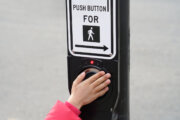Journalist Jacqueline Mendelsohn experienced mood swings and random bouts of crying with her first child.
“I remember bursting into tears as I brought my daughter home and walked through the front door, overwhelmed by the monumental change of bringing this tiny human into our lives forever,” she says.
But these “baby blues” were transient and soon dissipated.
What she experienced with her second, though, was much different. Struggling with breastfeeding, she felt defeated and exhausted from going into each nursing session with a deep pit of anxiety and fear.
“I couldn’t shake the feeling I was doing something wrong, that I wasn’t capable of feeding him,” she says. “I remember a feeling of just wanting to escape and having a hard time coping.”
After her husband found her sobbing on the bathroom floor, he encouraged her to reach out to her doctor and her therapist.
“I began to understand I was experiencing postpartum anxiety and depression centered around feeding and fueled by a lack of sleep,” she says.
Mendelsohn is not alone in both postpartum experiences. Although it may not seem like it, nearly all new moms experience some form of baby blues. A vast majority of women, up to 85%, experience the “baby blues,” a temporary fluctuation in moods. But for 1 in 7, these mood changes don’t get better and may get worse, leading to a more serious condition called postpartum depression, according to StatPearls.
“Few people will report feeling this way or talk explicitly about it, or they may not know they have it,” says Robyn Alagona Cutler, a therapist who specializes in maternal mental health and who has experienced postpartum anxiety. “It could seem like many people do not end up with baby blues, but the statistics tell us otherwise”
For new mothers (and fathers), it can be hard to tell when the tipping point from baby blues to postpartum depression happens — and it can be even harder to ask for help.
Here’s what to expect after you’re expecting when it comes to the baby blues, when you should reach out if it’s something more and — most importantly — how to tell the difference.
[SEE: 11 Signs of Postpartum Depression.]
What Are Baby Blues?
Baby blues begin shortly after birth and typically last less than three weeks.
Symptoms of baby blues include:
— Anxiety
— Sadness
— Irritability
— Feeling overwhelmed
— Crying
— Reduced concentration
— Appetite problems
[SEE: What to Know About Anxiety Medications.]
Causes of the Baby Blues
There are several causes of baby blues, including:
The rapid hormone drop after birth
Any rapid hormone change can cause mood fluctuations.
“The placenta is a hormone factory,” says Dr. Kailey Caplan, a reproductive psychiatrist with UTHealth Houston. “As soon as that’s out of you, your estrogen and progesterone drop dramatically.”
If you are susceptible to hormone-fueled mood changes, such as if you get bad PMS, she says you may be more likely to get the baby blues.
Lack of sleep
New moms are often the ones attending to their babies’ frequent overnight feedings, which disrupt their ability to get enough sleep. As a result, inadequate sleep causes irritability, stress and mood changes.
“I know personally, when I get my good eight hours, I can tackle the world. But if I’m getting two hours here and there, anything will set me off,” Caplan says.
Major life changes
New mothers can’t do many of the things they used to do to relax and take time for themselves.
“You’re basically a slave to this tiny, beautiful tyrant, and there’s a lot of adjusting that goes into that, as well as some identity changes,” Caplan says. “‘I’ve been (me) for 30 years, and now all of a sudden I’m a baby’s mom.”
[READ: What Is Neurofeedback Therapy?]
What Is Postpartum Depression?
Unlike baby blues, postpartum depression — also called perinatal depression or perinatal mood and anxiety disorders (PMADs) — doesn’t end after a few weeks.
“Anything that persists longer (than a few weeks) may be postpartum depression,” says Dr. Lauren Demosthenes, an OB-GYN and senior medical director with Babyscripts, a virtual care program for managing obstetrics.
It can even start up to a year after giving birth.
“Although some of the symptoms will be the same — mood fluctuations, overwhelm — perinatal depression comes with others as well,” Cutler says.
Symptoms of postpartum depression include:
— Anger and irritability
— Feelings of guilt and shame
— Loss of interest in things that used to bring joy
— Sadness
— Sleep and appetite disturbance
— A lack of interest in baby, self or others
Postpartum depression can lead to difficulty bonding with your baby, withdrawing from family and friends and worrying that you’re not a good mother. In some cases, you may have thoughts of harming yourself or your baby, or recurring thoughts of death or suicide.
“Intrusive thoughts about something bad happening to the baby, dropping the baby, even doing something bad to the baby are all very common in the postpartum period,” Caplan says.
Postpartum psychosis
However, it’s important to note that wanting to act on these thoughts, Caplan says, may be a sign of postpartum psychosis, a rare maternal mental health crisis.
Symptoms of postpartum psychosis include:
— Erratic behavior
— Delusion
— Hallucinations
Postpartum psychosis should be treated as a medical emergency by calling 911, going to the emergency room or calling or texting the National Suicide and Crisis Lifeline at 988.
[READ Pregnancy Checklist]
Risk Factors for Postpartum Depression
Anyone can develop postpartum depression, but there are certain factors that may cause some people to be more susceptible to postpartum depression, including:
A personal history of depression or other mental health issues
The number one risk factor for postpartum depression is a history of mental health conditions, especially depression.
“There are well-worn paths in your head that depression makes,” Caplan says, explaining that these neurological pathways can be triggered by stressful events, such as a new baby’s arrival.
A family history of depression or other mental health issues
Even if you’ve never had your own problems before, genetics may come into play.
“People who have a family predisposition towards depression but who have never had the right blocks fall into place may have a first depressive episode in the perinatal period,” Caplan says.
Age and situation
Two 2022 studies found certain groups to be more likely to experience postpartum depression:
— First-time mothers
— Younger mothers (incidence decreases with age)
— Mothers of twins
— Women with low social support from community, family or friends
Interestingly, fathers can get postpartum depression, too, particularly if they’ve dealt with mental health issues in the past.
“Their whole identity and schedule may be changed, and they’re not sleeping much either,” Caplan says. “It’s an adjustment disorder, so symptoms are directly related to the situation.”
[Rainbow Babies: Pregnancy After Miscarriage]
Baby Blues vs. Postpartum Depression
The main differences between baby blues and postpartum depression are:
— Length of time the symptoms last for. If you continue feeling down for more than a couple of weeks, it could be postpartum depression.
— Severity of your symptoms. Postpartum depression has all the feelings of baby blues such as frequent crying and mood shifts, but also comes with more severe emotions like guilt, worthlessness, anger and loss of interest.
— Ability to function. Another major clue to what you’re dealing with is whether you can take care of yourself and your baby.
“The big difference between postpartum blues and postpartum depression is the level of functioning. If you’re in tears when the pacifier is the wrong color or snapping at your partner because they did this to you but you’re still doing everything you need to do, that’s probably blues,” Caplan says. “It’s a measure of impairment.”
On the other hand, if you’re feeling so overwhelmed that you’re not able to perform normal daily functions — such as showering, eating or taking care of the baby — that’s not baby blues.
Mothers will be asked to fill out a questionnaire called the Edinburgh Postnatal Depression Scale (EPDS), a screening tool to identify postpartum depression in new mothers, at each postpartum followup and during pediatrician visits, but it is only helpful if you answer honestly.
Baby Blues Management
The baby blues don’t require medical treatment because they will resolve on their own. It is considered “normal” and should be expected and planned for, Cutler says.
Things that may help if you have the baby blues include:
— Having support people around who can help with your baby
— Resting whenever possible
— Understanding that this is common and asking for help is OK
— Eating a healthy diet
— Using a lactation support person if you are having trouble with breastfeeding
— Joining a new mom support group through your hospital, local La Leche League or social media, such as the Peanut app
Remember, the images of new motherhood we see on social media aren’t always reflective of reality.
“We have this beautiful Instagram fantasy of what new motherhood looks like, and it’s blissful with lots of pillows and rose petals, but that’s not real,” Caplan says. “Most of the time, it’s bodily fluids and screaming.”
Postpartum Depression Treatments
Many people still feel stigma around mental health challenges, particularly those during motherhood. Unfortunately, some people are reluctant to reach out for help for postpartum depression.
“Mothers are told we are supposed to feel happy and joyful. It’s very hard to say you are struggling as a mother,” Cutler says.
Not getting help affects not only you, but your child as well. After all, you will do a better job of taking care of your baby if you’re also taking care of yourself.
Untreated postpartum depression can alter attachment and bonding with your baby, which can impact their neurodevelopment, meeting milestones and even interactions later in life.
“It can affect your enjoyment and relationship with your child going forward,” Caplan says.
Thankfully, there are several ways to treat postpartum depression, including certain types of medications and psychotherapy.
Medications
After diagnosis, postpartum depression may be treated with certain types of medications including:
— Antidepressants and anti-anxiety medications. Selective serotonin reuptake inhibitors (SSRIs), such as sertraline (Zoloft), may be prescribed at a low dose to treat postpartum depression. They are effective in relieving depressive symptoms and are safe to use if you’re breastfeeding.
— Zuranolone (Zurzuvae). The first oral medication approved by the Food and Drug Administration for postpartum depression, zuranolone acts slightly differently in the brain than SSRIs. It’s fast-acting and is taken for only 14 days. However, it’s not yet clear how it affects breast milk production or breastfed babies.
Psychotherapy
Along with the same measures that improve baby blues, postpartum depression also requires the help of a perinatal mental health professional
, such as a licensed counselor, social worker, psychiatrist or psychologist.
Research has shown that cognitive behavioral therapy (CBT), a type of therapy, is effective in treating postpartum depression. CBT involves working to change thinking and behavior patterns to create healthier coping strategies.
Many hospitals, especially those part of large hospital systems, offer postpartum psychiatry appointments and other maternal mental health services, so be sure to ask your OB to connect you with those resources at your next appointment.
For immediate help, new moms can also call or text the National Maternal Mental Health Hotline at 1-833-TLC-MAMA to talk to a counselor for free.
Bottom Line
There is hope for future pregnancies for those who’ve experienced postpartum depression.
With her third child, Mendelsohn took a proactive approach by starting an SSRI in her third trimester, continuing talk therapy, and bringing in a live-in newborn specialist for the first 10 weeks postpartum.
“Implementing this system made a world of difference this time around,” she says. “Our baby is now 4 months old, and my husband and I are constantly commenting on how this has been my best postpartum yet.”
More from U.S. News
What to Know About Raw Milk: Myths, Safety and Nutrition
Red Dye in Foods: Uses and Health Risks
Plant-Based Diet vs. Vegan Diet: What Is the Difference?
Baby Blues vs. Postpartum Depression: What?s the Difference? originally appeared on usnews.com













